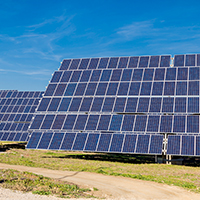What is solar thermal energy?

Solar thermal energy is the process of concentrating sunlight to create heat, which can be used to create electricity or to heat a home, its water supply and more. Solar thermal energy can be used as an alternative to solar panels or complement your solar panels to provide extra power.
Key insights
- Solar thermal energy uses the heat of the sun to produce electricity and home heating.
- There are many different solar thermal systems that can be incorporated into a home.
- Solar thermal energy saves money on electric bills and provides a clean energy source.
Understanding solar thermal energy
Solar panels use negative and positively charged silicon panels to create electricity, but solar thermal energy reflects sunlight from a mirror to a small area to heat it or uses dark-colored materials to absorb the heat of the sun. The heat is then used in one of three ways:
- It is transferred to a carrier like water or oil. That carrier is then used to heat rooms or water tanks.
- The heat is used to produce steam which runs a generator to create electricity.
- The heat is used to directly heat rooms, pool water, water in a water heater and more.
Some solar thermal energy systems that can be used in residential homes include concentrating solar systems, unglazed solar collectors, evacuated tube solar collectors, transpired solar air collectors and flat-plate solar collectors.
» DISCOVER: What is passive solar heating?
Concentrating solar systems
Unglazed solar collectors
» LEARN MORE: How does a solar pool heater work?
Flat-plate solar collectors
Water or other types of fluid circulates through the casing to be heated and can then be used to heat your home (through radiant floor panels, for example) or as your home’s heated water supply.
Evacuated tube solar collectors
Transpired solar air collectors
Benefits of solar thermal energy
Like other forms of solar, solar thermal energy can save you money on your electric bill. It also produces energy that is better for the environment.
Maybe one of the most lucrative reasons to incorporate solar thermal energy into your home is the fact that it allows you to be less reliant on the power grid. That’s good news for those living in states that often have brownouts or blackouts during storms, heatwaves or freezing temperatures.
Because solar thermal energy is typically used to heat a home rather than generate electricity, a thermal solar energy heating system is ideal if you want to complement a residential solar energy system.
» LEARN MORE: Solar energy vs. fossil fuels
Using solar thermal energy in your home
Thermal energy can be used in a variety of ways around your home. Here are a few ways you can take advantage of solar thermal energy.
- Solar thermal heaters can be used to heat swimming pools and hot tubs. The water is circulated through tubes that are heated using sunlight. Including installation, these systems cost between $2,500 and $4,000 and pay for themselves in energy savings in one to seven years.
- Solar thermal stoves and grills have become more popular in recent years. These use reflective surfaces to heat food without electricity. Unfortunately, they must be used outside since they need direct sunlight to operate. Solar grills and ovens range in cost from around $100 to $500.
- Hot water tanks and home heating systems can be powered by solar thermal heaters. Unglazed solar collectors, evacuated tube solar collectors, transpired solar air collectors and flat-plate solar collectors can all be used to heat homes. Evacuated tube collector systems can also be used to cool the home.
» DISCOVER: How do solar water heaters work?
FAQ
What is the difference between solar energy and solar thermal energy?
Solar panels use silicon cells and sunlight to create energy. Solar thermal energy uses mirrors or dark-colored materials to focus sunlight into one area to create heat. This heat can be used to create energy or to heat pools, food and homes.
What are the advantages of solar thermal energy?
Solar thermal power is a clean, renewable resource once you have your system in place. Also, some solar thermal power systems can be DIYed from common materials like soda cans and black tubing. There are many tutorials online that can get you started.
What is the most common solar thermal energy system?
The most common solar thermal energy systems use flat-plate collectors.
Article sources
- The American Society of Mechanical Engineers, “ 8 Hot Applications of Solar Thermal Power .” Accessed June 20, 2023.
- U.S. Environmental Protection Agency, “ Solar Heating and Cooling Technologies .” Accessed June 20, 2023.
- U.S. Department of Energy, “ Solar Swimming Pool Heaters .” Accessed June 20, 2023.
- U.S. Department of Energy, “ Active Solar Heating .” Accessed June 20, 2023.
You’re signed up
We’ll start sending you the news you need delivered straight to you. We value your privacy. Unsubscribe easily.
